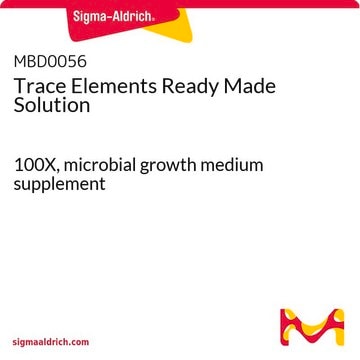MBD0055
MediaBoost
non-animal sterile microbial growth supplement
Sinónimos:
growth supplement for germination, microbial culture additive, microbial culture enhancer, microbial media supplement, minimal growth media supplement
About This Item
Productos recomendados
Nivel de calidad
esterilidad
sterile
formulario
liquid
técnicas
microbiological culture: suitable
Condiciones de envío
wet ice
temp. de almacenamiento
2-8°C
idoneidad
Bacillus spp.
Escherichia spp.
Lactobacillus spp.
Lactococcus spp.
Pseudomonas spp.
Saccharomyces spp.
bacteria
yeasts
Descripción general
- Chemically defined minimal growth media are often used to grow bacteria for proteomics, as a base for stable isotope enrichment in NMR protein structure-function studies, but growth can be limited without the addition of an effective supplement.
- Use of chemically defined minimal growth media in the production of secreted microbial proteins to ensure reproducibility and a higher concentration of the microbial-produced protein of interest.
Aplicación
- Bacillus subtilis spores in LB medium
- Lactobacillus rhamnosus in LB medium
- Pseudomonas aeruginosa in M9 medium
- Saccharomyces cerevisiae in YPD, BM2, and IMDM media
Please note strains and media combinations and should be tested on a case-by-case basis by the researcher for experiment optimization.
Características y beneficios
- Boosts Growth of Certain Microorganisms
- Reduces Germination Time
- Ready-Made, Sterile Solution
- Protein-Free
Producto relacionado
Código de clase de almacenamiento
12 - Non Combustible Liquids
Clase de riesgo para el agua (WGK)
WGK 3
Punto de inflamabilidad (°F)
Not applicable
Punto de inflamabilidad (°C)
Not applicable
Certificados de análisis (COA)
Busque Certificados de análisis (COA) introduciendo el número de lote del producto. Los números de lote se encuentran en la etiqueta del producto después de las palabras «Lot» o «Batch»
¿Ya tiene este producto?
Encuentre la documentación para los productos que ha comprado recientemente en la Biblioteca de documentos.
Nuestro equipo de científicos tiene experiencia en todas las áreas de investigación: Ciencias de la vida, Ciencia de los materiales, Síntesis química, Cromatografía, Analítica y muchas otras.
Póngase en contacto con el Servicio técnico





